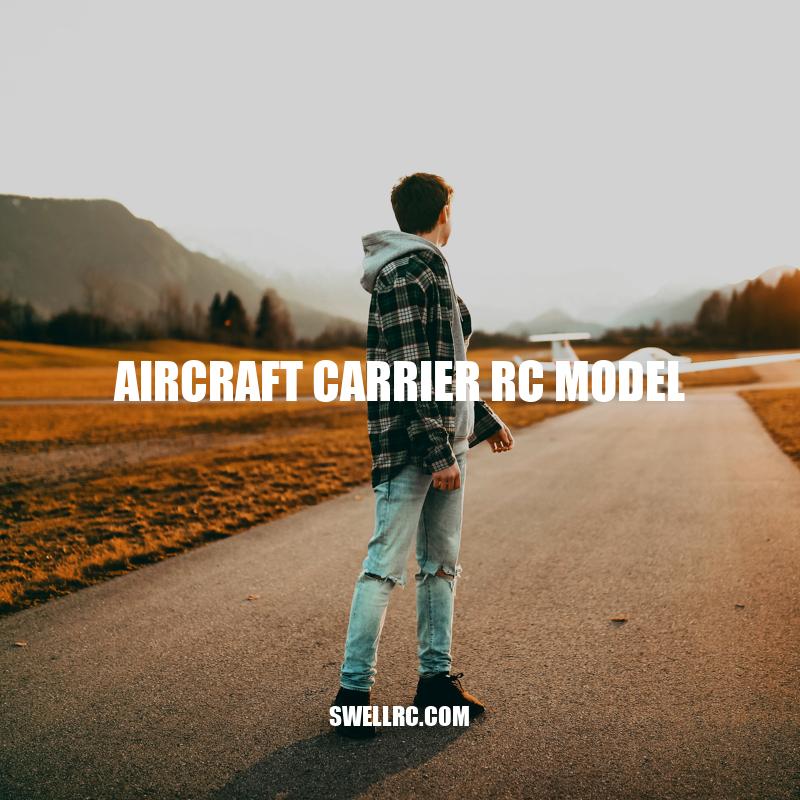Exploring the World of Aircraft Carrier RC Models
Aircraft Carrier RC Model: The Ultimate Remote-Controlled Ship
The Aircraft Carrier RC Model is one of the most impressive examples of remote-controlled technology available today. RC enthusiasts and collectors of model ships and airplanes have long been fascinated by the intricacies of these scale representations of real-life aircraft carriers. Built with precision, attention to detail, and a passion for all things aviation, these models are an engineering and artistic feat to behold. The Aircraft Carrier RC Model is a marvel of modern craftsmanship, allowing RC hobbyists to experience the thrill and excitement of commanding a naval vessel with the touch of a finger. With its exquisite design and authentic features, the Aircraft Carrier RC Model is a must-have for any serious collector or RC hobbyist. This article will delve into the world of Aircraft Carrier RC Models, exploring their design, features, building techniques, operation, and maintenance. We’ll provide tips and best practices for anyone interested in building and operating an Aircraft Carrier RC Model, as well as insights into the hobby’s history and future. Get ready to set sail and discover the wonders of these incredible machines!
The design and features of Aircraft Carrier RC Models are incredibly intricate and realistic. Here are some key features of these models:
- A scale representation of a real-life aircraft carrier
- Size can vary from miniature to larger than 6 feet in length
- May be constructed of plastic, wood, metal, or fiberglass
- Deck equipment including radar tower, communications equipment, deck cables, anchor chain, deck hatches, and much more
- Can hold replica planes, helicopters, and other scale aircraft on the deck
One of the most important aspects of Aircraft Carrier RC Model design is scale representation. Builders use blueprints and schematics to accurately model the ship’s proportions, key details, and layout. Plastic and wooden models are popular for their durability and ease of construction, while more experienced modelers may opt for metal or fiberglass for their customizability and realism. Deck equipment is an essential part of the model’s design, and builders often spend countless hours replicating the intricate details of the ship’s equipment. Some Aircraft Carrier RC Models can hold replica planes and other aircraft on their decks, adding another layer of realism to the model.
If you’re interested in purchasing an Aircraft Carrier RC Model, there are several websites where you can find them. Hobbytron, Horizon Hobby, and Motion RC are some popular websites that offer a wide range of models to choose from.
What materials are commonly used to construct Aircraft Carrier RC Models?
Aircraft Carrier RC Models are a popular hobby among enthusiasts. These models are realistic replicas of the actual aircraft carriers and can be used for play, display, or even for educational purposes. If you want to build your own Aircraft Carrier RC Model, the first thing you need to know is what materials are commonly used for construction.
One of the most common materials used for Aircraft Carrier RC Models is plywood. Plywood is a durable, lightweight material that is easy to work with. It is also readily available, making it a popular choice for model builders. Balsa wood is another popular choice. It is very lightweight and easy to shape, making it a great choice for the finer details of the model.
Fiberglass and plastic are also commonly used materials for Aircraft Carrier RC Models. These materials are durable and can be molded into different shapes and sizes. They are also resistant to water, making them ideal for models that will be used in wet environments.
In addition to the main construction materials, other materials are used for finishing touches on the model such as paints, decals, and adhesives. Paints are used to add color and detail to the model, while decals can add realistic markings and logos. Adhesives are used to hold everything together.
When choosing materials for your Aircraft Carrier RC Model, it is important to consider both the durability and weight of the materials. You want a model that is sturdy enough to withstand regular use but also light enough to be easily manipulated.
In conclusion, the most common materials used for Aircraft Carrier RC Models are plywood, balsa wood, fiberglass, and plastic. These materials provide durability and ease of use, making them ideal for model builders of all skill levels.
Building Techniques
There are a variety of techniques that can be used to build an Aircraft Carrier RC Model, from scratch-building to kit-building and modifying existing models. Here are some tips and techniques for creating the perfect model:
- Scratch-building involves creating a model from scratch using raw materials such as wood and metal.
- Kit-building involves assembling pre-made parts into a model according to the manufacturer’s instructions.
- Modifying existing models involves customizing an existing model by adding extra features or changing certain parts.
- Tools such as carving knives, sandpaper, and saws are used to shape, carve, and smooth the model’s parts.
- Blueprints and reference materials such as photos are used to guide the construction process
- Paints, decals, and other materials are used to add the finishing touches to the model
While building an Aircraft Carrier RC Model can be a challenging and time-consuming process, it can also be incredibly rewarding. Many builders find satisfaction in creating a highly detailed and accurate model from scratch, while others enjoy the customization options available through modifying existing models.
In addition to traditional building techniques, there are also options available for 3D printing an Aircraft Carrier RC Model. With advancements in technology, it is now possible to print a model using a 3D printer, allowing for even more detailed and accurate designs.
When building your model, it is important to keep in mind your budget and level of experience. Novice builders may want to start with a kit-building model, while more experienced builders may enjoy scratch-building or modifying existing models.
| Building Technique | Pros | Cons |
|---|---|---|
| Scratch-building | Complete customization, unique model creation | Requires high level of skill, expensive materials and tools |
| Kit-building | Easy to follow instructions, pre-made parts | Less customizability, limited to manufacturer’s instructions |
| Modifying existing models | Customizable without starting from scratch | Limited by the original model’s design and parts |
What are the pros and cons of scratch-building an Aircraft Carrier RC Model?
Scratch-building an aircraft carrier RC model is an exciting venture that can be both rewarding and challenging. While there are numerous benefits to creating your own model, there are also some drawbacks to consider beforehand.
One of the biggest advantages of scratch-building an aircraft carrier RC model is the ability to customize every aspect of the design. You have complete control over the size, shape, and materials used in order to create a truly unique model. Additionally, the level of detail you can achieve is remarkable. With the right skills, you can recreate every aspect of an aircraft carrier to an impressive degree of accuracy.
Another pro of scratch-building an aircraft carrier RC model is that it can be considerably less expensive than buying a pre-made model. While you will need to invest in materials and tools, these costs can be offset by the satisfaction of creating something yourself rather than paying for a finished product.
However, creating a model from scratch can be time-consuming and frustrating. You will need to acquire and master a variety of skills, including woodworking, metalworking, and electrical work. Depending on the level of complexity you desire, the process can take months or even years to complete. Additionally, creating a one-of-a-kind model means that there are fewer resources available to help troubleshoot any problems that arise.
Furthermore, creating a scratch-built model requires a large amount of work and effort. It is important to have patience and persistence, especially when experiencing setbacks along the way. Not everyone has the time or desire to put the extensive effort into fabricating a model from scratch.
In conclusion, scratch-building an aircraft carrier RC model can be a highly rewarding experience, but it is not for everyone. It requires a significant amount of time, skill, and patience in order to create a model that is both accurate and visually appealing. But, if you have the passion and determination, the end result can be a masterpiece of your own creation.
Once the Aircraft Carrier RC Model is built, it is important to know how to operate and maintain the model to ensure optimal performance and longevity. Here are some tips for getting the most out of your model:
- Be sure to use the appropriate power source for your model, such as rechargeable batteries or gasoline.
- Learn how to control the model using the remote controller, following the manufacturer’s instructions.
- Operate your model in a large, open area that is free of obstacles and other hazards.
- Avoid operating your model in inclement weather, such as high winds, rain, or snow.
- When storing your model, be sure to protect it from dust, moisture, and other potential hazards that could damage the model’s delicate parts.
- Regularly clean your model, especially after use, to ensure it always looks and performs great.
- Conduct regular maintenance checks to ensure the model’s parts are free from damage and in good working order.
One important consideration when operating and maintaining your model is safety. Always follow safe practices when operating your model, such as wearing protective gear, keeping a safe distance from others and avoiding operating the model near any sources of electrical or heat hazards.
If you’re having trouble with your model, be sure to consult the manufacturer’s manual or contact their customer support team for assistance. There are also online forums and communities for RC enthusiasts where you can connect with other enthusiasts and seek help and advice.
Overall, operating and maintaining an Aircraft Carrier RC Model can be a fun and rewarding experience for hobbyists of all ages and skill levels. By following these tips and practices, you can ensure your model looks and performs great for years to come.
What safety precautions should I take when operating and maintaining an Aircraft Carrier RC Model?
When it comes to operating and maintaining an Aircraft Carrier RC model, safety should always be the top priority. Here are some safety precautions you should take to ensure you and those around you stay safe:
1. Check Your Model: Before operating your RC Aircraft Carrier model, examine it to make sure all its parts are working properly. If you notice any issues, address them before you operate it.
2. Find a Safe Space: Make sure the area where you plan on operating your RC Aircraft Carrier is clear of any potentially hazardous materials or obstructions.
3. Wear Protective Gear: To protect yourself from any potential harm, consider wearing safety goggles and protective gloves when handling your model.
4. Learn How to Operate Your Model: Familiarize yourself with the controls and functions of your RC Aircraft Carrier model. You should have a good understanding of how to operate your model before putting it into use.
5. Know the Laws and Regulations: Look into local or national laws and regulations to make sure you understand what you can and cannot do with your RC Aircraft Carrier model.
6. Keep an Eye on Your Model: Never leave your model unattended while it is in operation. Always keep it in your line of sight.
7. Proper Maintenance: Regularly maintain your model and replace any worn or damaged parts immediately.
By following these safety precautions, you can enjoy operating and maintaining your Aircraft Carrier RC Model without any incidents.
Conclusion
In conclusion, Aircraft Carrier RC Models offer enthusiasts the chance to recreate the feeling of being in control of their own aircraft carrier on a much smaller scale. Whether scratch-building, kit-building, or modifying existing models, building an Aircraft Carrier RC Model offers the chance to be creative and gain new technical skills. Operating and maintaining these models require a certain level of care and attention, but the results are well worth the effort. Not only do they look amazing, but they are also a lot of fun to operate.
One of the great things about Aircraft Carrier RC Models is that they appeal to people of all ages and skill levels. Whether you’re an experienced RC hobbyist or just starting out, there’s a perfect model for you. Many online stores and hobby shops offer a range of models to suit any budget and preference.
In addition to the fun and excitement of operating these models, building an Aircraft Carrier RC Model can also provide insights into the historical significance and technical aspects of these massive ships. It can be an educational experience for both children and adults, promoting historical awareness and encouraging a love of technology and engineering.
Overall, Aircraft Carrier RC Models are a unique and exciting hobby that offers a chance to learn new skills, be creative, and have fun. With so many options available, there’s no reason not to get started today and build your own model.



